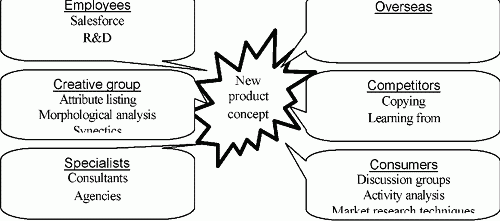Idea generation (NPD Stage 1)
Category: Marketing
Strategic factors, as well as the firm’s competence in new product development, will influence how rigorous the search for new product concepts will be. The environmental pressures prompting the search for new products will also have a significant bearing. If they concern chronic change affecting the fortunes of a key product then undoubtedly considerable attention will be given to the search for new product concepts, with the employment of a very wide range of sources and techniques and possibly resulting in quite radical new ideas. If the environmental pressures are less critical then more moderate search may be undertaken, perhaps confined to existing product/market scope (Ansoff’s market penetration) and resulting in a modified product rather than a radically new product.
Approaches to idea generation have been classified by Crawford as being based upon either consumer problems or reappraisals of products already on the market. In the first case, the object is to discover unmet needs or problems the consumer might have and to attempt to solve them through the development of new products. In the second case the approach is to consider the needs and problems that are currently being served by products (core products/benefits), and then to address them in new ways (actual and augmented product).
On the other hand, Souery classifies idea generation techniques into two groups: creative and analytical. The figure below is an amalgam of some of the principal sources and techniques used in idea generation:
Salesforce personnel have a unique position at the boundary of the organisation. Their routine contact with the trade, customers and competitors allows them to act as a channel for ideas from the market and possibly to conceive of new solutions to customer problems. Ideas may also stem from internal R&D. In science-based industries this may be by far the best source of innovation for some firms. In consumer product industries the emphasis in R&D may be the development of products after a concept has been generated.
Creative group indicates any group specifically charged with generating concepts, in the firm or an agency. Numerous techniques have been employed. Lateral thinking has been advocated by de Bono and Hisrich and Peters review many other possibilities, a few of which are noted below.
Attribute listing — a list of attributes relating to the problem is considered from a variety of viewpoints each attribute may be modified in turn and the consequences investigated.
Morphological analysis examines the relationships between all the possible variables in solving a problem. It requires the construction of relevant dimensions and the generation of solutions in every combination of the dimensions. Cafarelly illustrates this by taking five consumer benefits as one dimension and five product attributes as a second dimension
| Product attributes | Consumer Benefits |
| Shape | Nutrition |
| Colour | Flavour |
| Size | Eat wet or dry |
| Smell | Easy to eat or digest |
| Texture | Non fattening |
For each of the twenty five combinations of these dimensions a new product concept is conceived. As an example if this were related to cereals then the shape/nutrition cell might lead to a totally different idea to the smell/nutrition combination or the colour/easy to eat cell.
Synectics is a group process which uses analogy to unlock new ideas. How does nature solve that problem? How does another industry or culture view that problem? Cafarelli gives the example of cleaning teeth. The analogy was with cleaning an office block and the creative group had to imagine they were the cleaners moving in at the end of the day. They had to envisage the kinds of problem they would meet and how they would tackle them.
Customers might be a fruitful source of ideas. In industrial markets they may be able to articulate fully a problem they have and lay down lines along which solutions can be found. They may search actively for potential suppliers In consumer markets. It is usually necessary for the firm to initiate the contact with customers and to structure the procedure for obtaining their ideas. This could be simple observation of user activities how they prepare cook and eat their meals how they use their time or how they approach particular problems. It could involve bringing together a group for semi-structured discussion or more imaginative role-playing and other qualitative research. It might also use perceptual mapping.
Obtaining product ideas is but the first step; the remainder of the development process is aimed at whittling down the number to retain those most nearly matching the objective set when the process was initiated, and to refining the concept so that it meets market acceptance.

